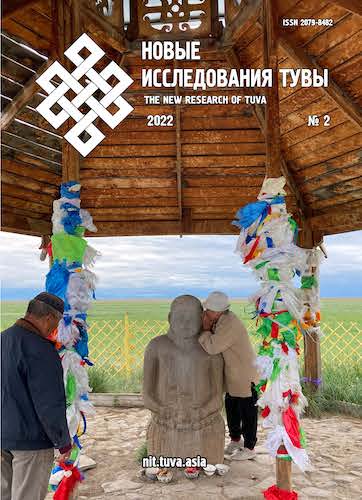Soviet modernity in visual perspective: the cases of Kalmyks and Tuvans
DOI:
https://doi.org/10.25178/nit.2022.2.17Keywords:
modernity; coloniality; decolonial approach; photography; Oirat-Kalmyks; Tuvans; Kalmykia; Tuvan People's Republic; Soviet period; visual image; visual sociology; visual anthropologyAbstract
The article examines from a visual perspective the early Soviet experience of modernity, as experienced by the Oirat-Kalmyks and Tuvans in the 1930s. This perspective allows us to consider the evidence of the Soviet project of creating a "new man" and establish the signs of modernity in the visual representations of these peoples. The article relies on the decolonial approach, which sees modernity as an epistemic framework, which in this case is inextricably linked with the Soviet colonial project.
The source base for the study is the photographic documents of the 1930s, preserved at the National Archives of the Republic of Tyva (Kyzyl, Russia), the National Archives of the Republic of Kalmykia and the N. N. Palmov National Museum of the Republic of Kalmykia (both in Elista, Russia).
The analysis of the 1930s photographs of the Oirat-Kalmyks and Tuvans revealed the visual canon for the photodocumentaries of the period, namely, the canon of representation and self-presentation of the "new man". Among other things, typical were a lack of femininity in the women's uniform, austerity, orderliness and discipline in both clothing and poses, standing at attention, white dress shirt, and the desire "not to stand out", look like everyone else, and merge into the group. In the course of study, further signs of modernity/coloniality were identified in the representation of corporeality, as well as in the life environment of the Oirat-Kalmyks and Tuvans. It was important to also focus on the common and the irregular in how the life of Oirat-Kalmyks and Tuvans was photodocumented and, respectively, in the visual signs of modernity/coloniality thus established. The common features include European-style clothing and headdresses, short haircuts for women, the use of Soviet symbols (flags, banners, or newspapers) to indicate the will for enlightenment, unity with the collective, and predominantly strict geometry of the group arrangement in space. However, although the Oirat-Kalmyks and Tuvans as participants in the project of creating a "new man" were represented in a pretty uniform manner, there is a good deal of irregularity and difference in their visual images, determined by specific trajectories the Soviet modernity took to reach these people. Including their previous experience of modernity, how well these people preserved their traditional culture, and the cultural codes that worked in them to normalize body practices.
References
Aleksandrov, E. V. (1997) Sistema vizual'noi antropologii v Rossii: stupeni «pogruzheniia» i problemy [The system of visual anthropology in Russia: stages of "immersion" and problems]. In: Material'naia baza sfery kul'tury [The material base of the sphere of culture] / ed. by S. G. Kolesnichenko. Issue 1. Moscow, Informkul'tura. 122 p. Pp. 14–18. (In Russ.).
Artaev, S. N. and Shurungova B. A. (2019) Pozy kak znaki neverbal'nogo povedeniia [Postures as signs of nonverbal behavior]. Vestnik Kalmytskogo universiteta, no. 1 (41), pp. 78–85. (In Russ.).
Aiyzhy, E. V., Mandan-Khorlu, M. M. and Mongush, A. Ch. (2019) Istoriia sozdaniia kollektsii V. P. Ermolaeva kak chasti etnograficheskogo istochnika izucheniia material'noi i dukhovnoi kul'tury tuvinskogo etnosa (chast' 1) [V.P. Yermolaev’s collection as an ethnographic source for studies of Tuvan material and spiritual culture. Part 1]. Oriental Studies, no. 12 (4), pp. 669–681. (In Russ.). DOI: https://www.doi.org/10.22162/2619-0990-2019-44-4-669-681
Baduginova, M. V. (2011) Rol' «Krasnykh kibitok» v sisteme okhrany zdorov'ia naseleniia Kalmykii v 1927–1931 gg. [The role of the “Red Wagons” in the system of public health protection in Kalmykia in 1927–1931.]. Vestnik KIGI RAN, no. 2, pp. 37–41. (In Russ.).
Barthes, R. (1989) Izbrannye raboty: Semiotika: Poetika [Selected works: Semiotics: Poetics]: transl. from Fr., comp. and ed. by G. K. Kosikov. Moscow, Progress. 616 p. (In Russ.).
Beck, U. (2000) Obshchestvo riska. Na puti k drugomu modernu [Risk Society: Towards a New Modernity] / transl. from Germ. by V. Sedel'nik and N. Fedorova. Moscow, Progress-Traditsiia. 384 p. (In Russ.).
Bogdanova, N. M. (2012) Fotografiia kak instrument sotsiologicheskogo analiza praktik konstruirovaniia vizual'noi samoprezentatsii [Photography as a tool of sociological analysis of the practices of constructing visual self-presentation]. Zhurnal sotsiologii i sotsial'noi antropologii, vol. XV, no. 2 (61), pp. 98–113. (In Russ.).
Golovneva, E. V. and Golovnev, I. A. (2021) Opyty izucheniia i vizual'noi reprezentatsii Kamchatki i Sakhalina v kontse XIX — nachale XX v. [Experiments in the study and visual representation of Kamchatka and Sakhalin in the late XIX — early XX century]. In: Liudi imperii — imperiia liudei: personal'naia i institutsional'naia istoriia Aziatskikh okrain Rossii [People of the Empire — Empire of the People: personal and institutional history of the Asian outskirts of Russia] : collection of scientific articles / N. G. Suvorova (ed.). Omsk, Publishing House of Omsk State University named after F. M. Dostoevsky. 648 p. Pp. 287–296. (In Russ.). DOI: https://www.doi.org/10.52468/978-5-7779-2573-2.2021.287-296
Golubev, A. (2021) Rets. na kn.: Jeff Sahadeo. Voices from the Soviet Edge: Southern Migrants in Leningrad and Moscow. Ithaca; L.: Cornell University Press, 2019. 273 p. [A Review of: Jeff Sahadeo. Voices from the soviet edge: southern migrants in Leningrad and Moscow. Ithaca; London: Cornell University Press, 2019, 273 pp.]. Antropologicheskij forum, no. 48, pp. 227–238. (In Russ.). DOI: https://www.doi.org/10.31250/1815-8870-2021-17-48-227-238
Devid-Foks, M. (2016) Modernost' v Rossii i SSSR: otsutstvuiushchaia, obshchaia, al'ternativnaia ili perepletennaia? [Modernity in Russia and the USSR: absent, common, alternative or intertwined?]. Novoe literaturnoe obozrenie, no. 16 [online] Available at: https://www.nlobooks.ru/magazines/novoe_literaturnoe_obozrenie/140_nlo_4_2016/article/12048/ (access date: 21.03.2022). (In Russ.).
Zhukovskaia, N. L. (2002) Kochevniki Mongolii. Kul'tura. Traditsii. Simvolika [Nomads of Mongolia. Culture. Traditions. Symbolism]. Moscow, Vostochnaia literatura. 248 p. (In Russ.).
Ivanova, G. M. (2018) Sovetskaia shkola v 1950–1960-e gody [Soviet school in the 1950s and 1960s]. Moscow, Fond «Moskovskoe vremia». 432 p. (In Russ.).
Istoriia Tuvy [The History Of Tuva] (2007): in 3 vols. / ed. by V. A. Lamin. Novosibirsk, Nauka. Vol. 2. 430 p. (In Russ.).
Kantor, K. M. (1990) Dva proekta vsemirnoi istorii [Two projects of world history]. Voprosy filosofii, no. 2, pp. 76–86. (In Russ.).
Lindsey, J. (2011) Vse o tsvete [All about color]. Moscow, Knizhnyi Klub 36.6. 432 p. (In Russ.).
Maady, S. S. (2021) Sumonnye shkoly-internaty v period Tuvinskoi narodnoi respubliki [Sumon boarding schools during the Tuvan People’s Republic]. Mir nauki, kul'tury, obrazovaniia, no. 2 (87), pp. 147–149. (In Russ.). DOI: https://www.doi.org/10.24412/1991-5497-2021-287-147-149
Oliadykova, L. B. (2007) Bezekvivalentnaia leksika i frazeologiia v poeticheskoi kartine mira Davida Kugul'tinova (na materiale proizve denii v russkom perevode) [Non-equivalent vocabulary and phraseology in the poetic picture of the world by David Kugultinov (based on the material of works in Russian translation)]. Elista, ZAOr «Dzhangar». 384 p. (In Russ.).
Popkov, Yu. V. and Tiugashev, E. A. (2022) «Zateriannyi mir»: tuvinskaia kul'tura v tsentr-periferiinoi interpretatsii geokul'turnogo i sotsiokul'turnogo prostranstva [“The lost world”: Tuvan culture in the center-periphery model of the geocultural and sociocultural space]. New Research of Tuva, no. 1, pp. 225–236. (In Russ.) DOI: https:// www.doi.org/10.25178/nit.2022.1.15
Sartikova, E. V. (2010) Narodnoe obrazovanie kak mekhanizm sovetskoi modernizatsii Kalmykii (20–30-e gg. XX v.) [Public education as a mechanism of Soviet modernization of Kalmykia, 1920s-1930s]. Vestnik Rossiiskogo universiteta druzhby narodov. Seriia: Istoriia Rossii, no. 4, pp. 145–151. (In Russ.).
Scott, D. (2017) Iskusstvo byt' nepodvlastnym. Anarkhicheskaia istoriia vysokogorii Iugo-Vostochnoi Azii [The art of being out of control. Anarchic History of the Highlands of Southeast Asia]. Moscow, Novoe izdatel'stvo. 408 p. (In Russ.).
Usmanova, A. (2007) Sovetskaia vizual'naia kul'tura kak ob"ekt antropologicheskogo issledovaniia [Soviet visual culture as an object of anthropological research]. In: Vizual'naia antropologiia: novye vzgliady na sotsial'nuiu real'nost' [Visual Anthropology: New views on social reality] : collection of scientific articles / ed. by E. R. Iarskaia-Smirnova, P. V. Romanov and V. L. Krutkin. Saratov, Nauchnaia kniga. 527 p. Pp. 18–27. (In Russ.).
Khovalyg, R. B. (2018) Tuvinskaia traditsionnaia odezhda [Tuvan traditional clothing]. Novosibirsk, Nauka, NGOPO Soiuza pisatelei Rossii. 336 p. (In Russ.).
Chatterjee, A., Southwood, M. H. and Basilico D. (1999) Verbs, events, and spatial representations. Neuropsychologia, no. 37, pp. 395–402.
Eisenstadt, S. N. (2000) Multiple Modernities. Daedalus, vol. 129, no. 1, pp. 1–29.
Gentile, E. (2006) Politics as religion / transl. by G. Staunton. Princeton, Princeton University Press. 168 p.
Harper, D. A. (2012) Visual sociology. New York, Routledge. 294 p.
Kress, G. and Van Leeuwen, T. (2001) Reading Images: The Grammar of Visual Design. London, Routledge. 310 p.
Mignolo W. and Walsh C. (2018) On decoloniality: concepts, analytics, praxis. Durham, Duke University Press. 291 p.
Mignolo, W. (1995) The Darker Side of the Renaissance: Literacy, Territoriality, & Colonization. University of Michigan Press. 420 p.
Quijano, A. (2007) Coloniality and Modernity/Rationality. Cultural Studies, vol. 21, issue 2–3, pp. 168–178.
Rothbard, M. N. (1990) Karl Marx: Communist as Religious Eschatologist. The Review of Austrian Economics, vol. 4, pp. 123–179.
Tlostanova, M. and W. D. Mignolo (2012) Learning to unlearn: decolonial reflections from Eurasia and the Americas. Columbus, Ohio State University Press. 281 p.
Wagner, J. (2002) Contrasting images, complementary trajectories: sociology, visual sociology and visual research. Visual Studies, vol. 17, no. 2, pp. 160–171. DOI: https://www.doi.org/10.1080/1472586022000032233
Znamenski, A. (2021) Socialism as a secular creed: a modern global history. Lanham, Lexington Books. 451 p.
Published
How to Cite
For citation:
Chetyrova L. B. and Sergeeva N. M. Sovetskaia modernost’ v vizual’noi perspektive (na primere oirat-kalmykov i tuvintsev) [Soviet modernity in visual perspective: the cases of Kalmyks and Tuvans]. New Research of Tuva, 2022, no. 2, pp. 239-262. DOI: https://www.doi.org/10.25178/nit.2022.2.17
Issue
Section
Copyright (c) 2022 Журнал "Новые исследования Тувы" (составление)

This work is licensed under a Creative Commons Attribution-NonCommercial 4.0 International License.

Author(s) license holder(s) grant rights for their work to the journal (grantee of a license) under the simple non-exclusive open license in accordance with Art. 1286.1 «Open license for a research work, work of literature or fine arts», Civil Code of the Russian Federation.
New Research of Tuva publishes articles under the Creative Commons Attribution-NonCommercial license (CC BY-NC).
Since it is an open license, author(s) reserve the right to upload the article to their institutional repository, submit it to another journal (if it allows republications), or republish it on their own website (in full, or in part).
However, several conditions apply here:
a) The republished version must always contain the name(s) and affiliation(s) of the author(s), the original title and the hyperlink to the original version on the New Research of Tuva website;
b) It must be in open access, free of charge, and no category of readers must be in any way whatsoever advantaged over general readership.
c) should the contribution be submitted elsewhere by its author(s) without substantial modification (30% or more of original text unchanged), the body of the article should contain a disclaimer that the original version was published in New Research of Tuva (with a link to the respective page)
The CC-BY-NC is a non-revocable license which applies worldwide and lasts for the duration of the work’s copyright.










